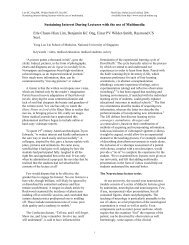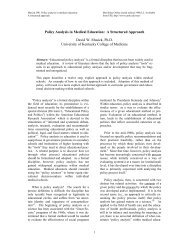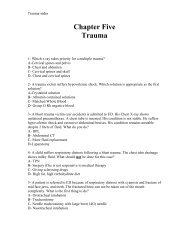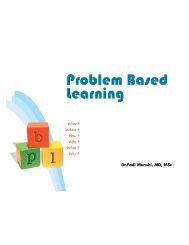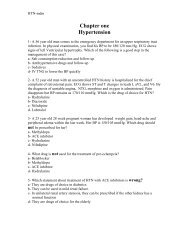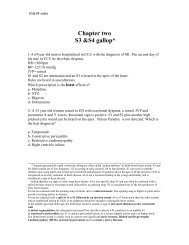Characteristics of Students Failing Medical Education: An Essay of ...
Characteristics of Students Failing Medical Education: An Essay of ...
Characteristics of Students Failing Medical Education: An Essay of ...
Create successful ePaper yourself
Turn your PDF publications into a flip-book with our unique Google optimized e-Paper software.
Mcloughlin CS. <strong>Characteristics</strong> <strong>of</strong> <strong>Students</strong> <strong>Failing</strong> <strong>Medical</strong> <strong>Education</strong>:<br />
<strong>An</strong> <strong>Essay</strong> <strong>of</strong> Reflections.<br />
the student’s need to ‘cycle‐back’ each time a higher‐order<br />
interpretation or advanced information-retrieval is<br />
demanded. The student treats information as though it<br />
originates from within encapsulated, discrete and separate<br />
entities; without regard to the possibility that linkages between<br />
otherwise apparently unrelated information might<br />
need to be sought out, or even cultivated. Essentially,<br />
the symptom-pursuit strategies are grossly and dangerously<br />
inefficient because the significance <strong>of</strong> relationships<br />
across information units is unappreciated.<br />
Simultaneous Processing: The manipulation <strong>of</strong> information<br />
through the thoughtful selection <strong>of</strong> personally<br />
relevant strategies and the imposition <strong>of</strong> ‘meaning’<br />
upon a databank <strong>of</strong> otherwise disparate facts.<br />
Key points<br />
• Requires the student to arrange information into a<br />
group or network.<br />
• Requires that the student thoroughly comprehend the<br />
information being confronted; rather than approaching<br />
it as a series <strong>of</strong> unrelated facts susceptible to being<br />
learned using rote memory devices,<br />
• Each segment <strong>of</strong> a reading (or diagnostic task) is related<br />
to every other part <strong>of</strong> that task (i.e., the whole<br />
can be surveyed as a consequence <strong>of</strong> considering the<br />
relationships within the whole). Thus, simultaneousthinking<br />
students can ‘jump’ to the central idea because<br />
they can see the relevance <strong>of</strong> each main idea to<br />
all other main and subordinate ideas.<br />
Student’s behavioral clues and examples <strong>of</strong> activities:<br />
The student using simultaneous processing strategies<br />
seeks out logical relationships between sets <strong>of</strong> information.<br />
<strong>An</strong>d, where these are not immediately evident, this<br />
student attempts to impose a personalized interpretation<br />
<strong>of</strong> meaning onto the data set. The student can perceive<br />
abstract relationships, identify higher‐order meaning, and<br />
differentiate the relative importance <strong>of</strong> ideas embedded<br />
in a complex reading (or task). The student creates several<br />
personalized strategies for manipulating information<br />
(e.g., develops personally meaningful mnemonics). Thus,<br />
when the student incorporates someone else’s mnemonic<br />
it is purposely modified to make it personally meaningful.<br />
Observations: This personalized-study-approach<br />
makes it easier for an evaluator <strong>of</strong> the student’s ‘study<br />
skills’ to assume that each stratagem is inefficient or irrelevant<br />
since the student’s approach does not reflect that<br />
<strong>of</strong> the evaluator. However, idiosyncrasy is inherent within<br />
personalizing. The true measure <strong>of</strong> the efficiency <strong>of</strong> the<br />
student’s approach is answered by the test <strong>of</strong> pragmatism:<br />
Does it work? It would be wrong to deduce that<br />
the simultaneous processing student studies effort‐free;<br />
however, the time that is expended brings more lasting<br />
results and an improved outcome when compared to the<br />
linear thinker.<br />
A rule‐<strong>of</strong>‐thumb problem solving index that I use<br />
is to ask about the student’s selection <strong>of</strong> a medical specialty.<br />
Whatever their stage in medical education this is a<br />
universal experience. It is remarkably typical for failing<br />
students to have made their initial selection—then never<br />
to have gone back to re‐evaluate that choice with updated<br />
information learned on the journey through medical<br />
school. Many times the trigger for the initial choice was<br />
itself ill‐informed (a television portrayal, someone they<br />
once knew in a particular specialty, a traditional family<br />
role, or presumed higher income prospects). Particularly<br />
frightened to evaluate their own initial decision to go to<br />
medical school are the very same students who themselves<br />
see their options for continuing as being snatched<br />
away.<br />
In this exercise I ask the failing student to tell me<br />
what data they accrued to make their current choice. Do<br />
they know the influences on their choice? I also evaluate<br />
their degree <strong>of</strong> self‐knowledge. Have they factored in<br />
their own values, needs and desires into the selection <strong>of</strong><br />
a medical specialty? Do they ever engage in self-assessment<br />
as a personal-retreat? That is, do they ever attempt<br />
an appraisal <strong>of</strong> their pr<strong>of</strong>essional and social aspirations?<br />
Typically, students in difficulty have a poor understanding<br />
<strong>of</strong> self. At the most basic level, some even appear not<br />
to know where their strengths lie in the traditional triad—<br />
people, information, and things.<br />
Efficient information‐organization involves meaningfully<br />
storing data so as to be later able to retrieve it<br />
efficiently. Most students-in-difficulty focus on retrieval,<br />
assuming that the storage mechanism will take care <strong>of</strong><br />
itself. They have forgotten (or perhaps never knew) that<br />
efficiency in storage is the primary limiter to one’s later<br />
ability to retrieve. When they do organize information,<br />
it is done idiosyncratically and exclusively according<br />
to class topic, organ system, or even the academic year<br />
when it was initially taught. Such a study-approach treats<br />
academic lecture classes as though each teaches discrete<br />
pools <strong>of</strong> medical knowledge that are unitary and ultimately<br />
separate; knowledge units are thoroughly compartmentalized.<br />
These comments also address the student’s<br />
approach to planning processing, which now will be<br />
briefly addressed.<br />
4<br />
Med Educ Online [serial online] 2009;14<br />
doi;10.3885/meo.2009.L0000029<br />
Available from http://www.med-ed-online.org



